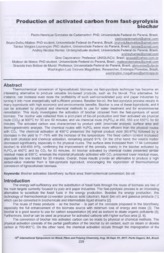Production of activated carbon from fast-pyrolysis biochar.
Production of activated carbon from fast-pyrolysis biochar.
Author(s): CADEMARTORI, P. H. G. de; MATTOS, B. D.; LOURENÇON, T. V.; HARRES, A. N.; CAPOBIANCO, G.; MATOS, M. de; BOLZON DE MUNIZ, G. I.; MAGALHAES, W. L. E.
Summary: Thermochemical conversion of lignocellulosic biomass via fast-pyrolysis technique has become an interesting alternative to produce valuable bio-based products, such as the bio-oil. This alternative, for instance, can increase even more the profitability of such well-consolidated pulp and paper industries by turning it into more energetically self-sufficient processo Besides bio-oil, the fast-pyrolysis process results in many byproducts with high economic and environmental benefits. Biochar is one of these byproducts, and it can be activated by physical and chemical methods to use for water treatment and for environmental remediation. This study investigates the activation of biochar obtained from the fast-pyrolysis of wood biomass. The biochar was collected from a pilot-plant of bio-oil production and then activated via physical route (C02) at 800°C for 30 and 60 minutes; and via chemical route (H3P04) at 450, 550 and 650°C for 60 minutes. The activated carbon was characterized by product yield, proximate analysis, surface area and thermogravimetric analysis. The chemical routes with H3P04 were more efficient than the physical routes with CO2. The chemical activation at 450°C presented the highest product yield (80.47%) followed by a decrease in the yield to 71-75% with the increase of the temperature. The fixed carbon content increased after both physical and chemical activation, remaining around 91%. On the other hand, the volatile matter decreased significantly, especially in the physical routes. The surface area increased from 17.94 (untreated biochar) to 450-655 m2/g, confirming the improvement of the porosity, mainly in the biochar activated by H3P04 at 450°C and by CO2 for 60 minutes. Ali biochar activated by chemical routes presented similar residual mass at 600°C, whereas the material physically activated with CO2 presented lower residual mass, especially the one treated for 30 minutes. Overall, these results provide an alternative to produce a high added-value material from a fast-pyrolysis byproduct, encouraging the exploration of thermochemical conversion of lignocellulosic biomass.
Publication year: 2017
Types of publication: Paper in annals and proceedings
Unit: Embrapa Forestry
Observation
Some of Embrapa's publications are published as ePub files. To read them, use or download one of the following free software options to your computer or mobile device. Android: Google Play Books; IOS: iBooks; Windows and Linux: Calibre.
Access other publications
Access the Agricultural Research Database (BDPA) to consult Embrapa's full library collection and records.
Visit Embrapa Bookstore to purchase books and other publications sold by Embrapa.

